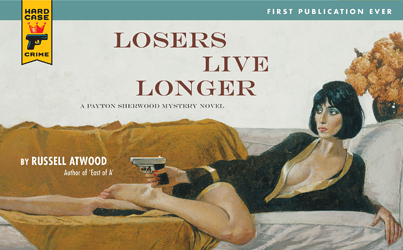
Any post about Russell Atwood's new crime novel Losers Live Longer (2009) has to start with the cover design: freed from traditional orientation by the extinction of the drugstore spinner rack, Robert McGinnis lets his long-legged lady (and, oh, how long-legged his ladies always are!) recline, a snub-nosed pistol resting in her hand almost as comfortably as she's resting in (and out of) her robe. It's one of the most striking covers Hard Case Crime has produced--booksellers, you should stock this one for the cover alone.
Fortunately, the contents prove worthy of the cover. As much fun as Hard Case's reprints and rediscoveries can be, it's the new books that are the most exciting, because it's always interesting to see the noir sensibility adapted to contemporary life--and because a good book by a working writer always holds out the promise of more. Russell Atwood's contribution to the genre is perhaps best summed up by the update of Raymond Chandler that passes through the head of his detective, Payton Sherwood, as he follows a lead through the East Village: "Down these gentrified streets a man must go . . . "
Sadly for Sherwood, those streets--his stomping ground--haven't been so productive lately, and as the novel opens he's sold most of his furniture, is in hock to his parents, and it looks like his days as a detective just might be numbered. (A former colleague, seeing his primitive computer setup, cracks, "What, you still using dial-up? Shit, Payton, churn your own fucking butter, too?") But then he gets five clients in one day.
Of course, a couple of them die, a couple of others pull guns on him and/or crack him over the head, and they're all, to no one's surprise (including his) connected . . . but you take what you can get, right? Atwood's plot is brisk and nicely complicated; this is the sort of novel wherein it occurs to you and the detective at the same time that a whole day has passed since you opened the book and he hasn't had a moment to take a deep breath, let alone eat or sleep.
The East Village got its moment in the reading public's sun last year with Richard Price's Lush Life. But whereas Price bore down on the neighborhood like an anthropologist, sussing out its various tribes and traditions, and the complicated commerce among them, Atwood simply immerses us in the streets, from Alphabet City all the way to the Hudson. This novel is about the city not because it can teach us important lessons about The Way We Live Now, but because the city is home, its quirks and dangers a part of the character of those who live there.
That doesn't mean Atwood's not interested in commenting on the urban environment--where would a hardboiled detective be without some ruminations on place and change?--but it does mean he approaches the subject with a lightness, and a humor, that is entirely absent from Price's work. This passage, which follows Sherwood rushing out the door of his office without his keys, or his shoes, is a good example:
But not to worry, this was the East Village. There'd be shoes. Time was you couldn't turn a corner in this neighborhood without coming across a tossed-out pair of two-tone loafers, or snakeskin cowboy boots, or zebra-striped high-tops, or glittery platform pumps. Things couldn't have changed that much.With that sort of wry sensibility, buttressed by self-deprecating humor and pleasantly understated pop culture references (I particularly enjoyed a throwaway reference to Jerome Bixby's "It's a Good Life."), Payton Sherwood is good company: bull-headed, unlucky, a sucker for attractive brunettes, with just enough of the knight-errant about him to ensure that a steady supply of beatdowns will keep coming his way.
This is the East Village, I told myself, there'll be shoes.
Unless, of course, the neighborhood had changed that much, like the rest of the city around it, desecrated and desiccated, its character and flavor all but gone. If so, then I was lost here.
Your neck of the woods, Owl had said. Yeh, 'cept these weren't my woods anymore, and now there was only my neck.
In addition, Atwood offers just enough hints of a convincingly detailed backstory to suggest that Sherwood really does have a life beyond the novel; though his earlier novel featuring Sherwood, East of A (1999) is out of print, I've just ordered a used copy and will be interested to see what else Atwood has to tell us about him. Here's hoping it doesn't take him ten more years to write a third.
I might have to get that for the cover alone. Plus I'm a sucker for anything set in the East Village, being no longer set in the East Village myself.
ReplyDelete